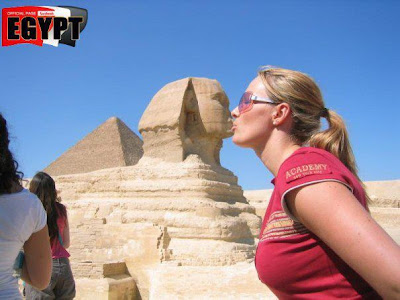Paintings and statues of Queen Meresankh III and members of her family inside her tomb at Giza in Egypt on July 24, 2012. Egyptian authorities are opening new tombs in an attempt to woo tourists back to their country, after a slump in the industry since last yeat's revolution.
A hunter throws a net to catch water birds, craftsmen make papyrus mats while a stream of people carry baskets filled with offerings for the afterlife.
The weapon was used by the U.S. Air Force decades ago.
Egypt’s tourism industry has been battered since last year’s revolution, but here, beside the pyramids of Giza, officials are trying to attract the visitors back.
The tomb of Meresankh, whose name means lover of life, will be opened to the public for the first time in nearly 25 years later this year, while five other tombs of high priests — buried under the desert sands for decades — will be thrown open.
“We want to give people a reason to come back, to give them something new,” said Ali Asfar, director general of archaeology on the Giza plateau.
Meresankh was a woman whose life was intimately bound up in the pharaoh’s incestuous rule. Her tomb lies a stone’s throw east of the Great Pyramid of her grandfather Khufu, better known as Cheops.
Her parents were brother and sister, and she married another of Khufu’s children — her uncle, Khafre, better known as Chephren, who built the second-largest pyramid here.
But Meresankh died suddenly, before her mother, who gave her own burial chamber for her daughter’s use.
American archaeologist George Reisner wrote of his delight at the discovery in 1927 as his team poked their heads through a gap at the top of the sand-filled doorway.
“Our eyes were first startled by the vivid colors of the reliefs and inscriptions around the northern part of this large chamber. None of us had ever seen anything like it,” he wrote in the magazine of the Museum of Fine Arts in Boston, where a statuette of Meresankh and her mother is housed.
Smaller but still interesting
On the other side of the Great Pyramid, the western cemetery houses the tombs of high priests, such as Kaemankh, the royal treasurer and keeper of the king’s secrets.
It took site inspector Ashraf Mohie El Din and a team of more than 50 people around five months to clear about three feet of sand that had blanketed the area and clean the tombs.
Mohie El Din said that climbing the ladder into Kaemankh’s burial chamber was “one of my favorite adventures.”
It is not hard to see why. On the walls, more vivid and colorful paintings show fishing on the Nile, a cow being slaughtered and another giving birth. In the cramped space around the sarcophagus, Mohie El Din shines his torch on an “ancient party” with dancers and musicians playing harp and flute. Just above, carpenters make a bed and a chair.
To the south of Cairo, authorities are also planning to reopen the famous Serapeum at Sakkara, a massive underground temple where sacred bulls were thought to have been buried in the huge granite and basalt sarcophagi — each weighing 60 to 100 tons — that sit in chambers flanking the long galleries.





